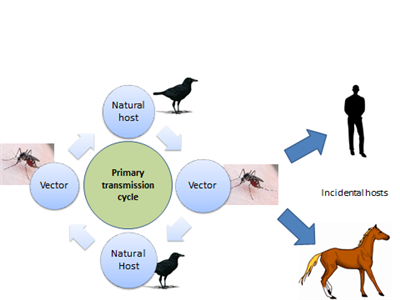Vector Borne
Studying the epidemiology of infectious diseases that are transmitted to humans via vectors (such as mosquitoes or flies), we need to know more about the relationship between the reservoir of the infectious agent and the vector that is needed to transmit the disease. The fact that a vector is required between the reservoir and the host will make the spread of the disease within a population more complex to study and predict.
The basis of vector borne disease epidemiology is the triangle between pathogen, vector and hosts. As with other type of infectious diseases, the pathogens (virus, parasites, bacteria) cause disease, yet they depend on the vector to be transmitted to the hosts. The natural (or primary) host of a vector-borne disease is part of the reservoir that maintains the pathogen in natural cycles of infection and transmission by vectors to other susceptible natural hosts. For example, in West Nile Virus, the primary transmission cycle takes place among various bird species and a number of mosquito species. In most birds in Europe, Africa and Asia, fatal outcome is rare when infected with West Nile Virus, in contrast to birds in the Americas (especially the family of crows). In this particular example of West Nile Virus, humans and horses are incidental (dead - end) hosts; this means that they do not contribute to the further spread of the disease.
Fig 1. Example of vector borne disease transmission: the West Nile Virus cycle
Modes of transmission of vector borne diseases
Vertical transmission from vector (e.g. mosquito) to progeny may occur via transoverial passage of the infectious agent.
Horizontal transmission occurs when infected mosquitoes transfer the agent to vertebrate hosts. This can be mechanical (e.g. when the agent is transferred by the vector via the mouth parts, without multiplication in the vector) or biological (where the agent multiplies in the vector).
Surveillance of vector borne diseases
Surveillance can target the vector:
- measuring abundance and spread
- testing vectors for infection (if tests exist for such investigation)
- calculate vector infection rates
Surveillance can target hosts:
- Sentinel animals, via periodic bleeding and testing for infection
- Via notification of animal or human infections / disease.
FEM PAGE CONTRIBUTORS 2007
- Contributors
- Arnold Bosman
Root > Assessing the burden of disease and risk assessment > Field Epidemiology > Outbreak Investigations > Confirm the outbreak > Types of Outbreak
